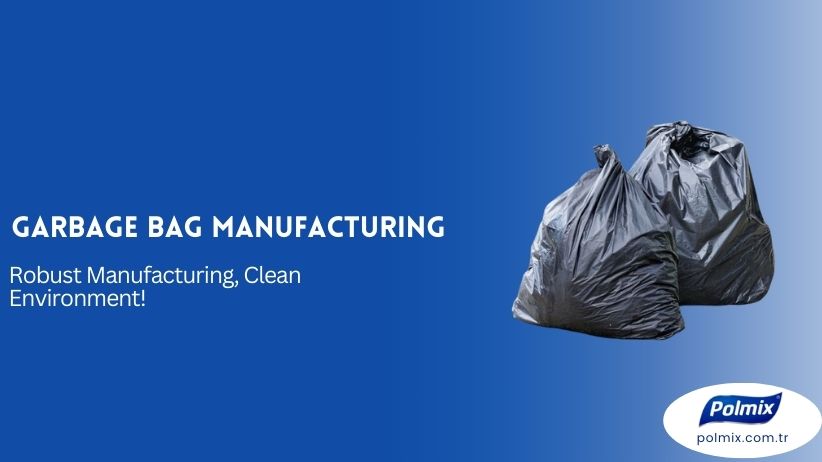Çöp Torbası İmalatı
What are the materials used in garbage bag production?
The materials used in garbage bag production are one of the most important factors that determine both product quality and environmental impacts. Polyethylene (PE) derivatives are mostly preferred. Polyethylene can be low density (LDPE) or high density (HDPE). LDPE provides flexibility and durability, while HDPE is tougher and tear resistant. For those who want to buy wholesale garbage bags, material selection is very important depending on the purpose of use. While thick and durable bags are required in industrial areas, thin and light bags may be sufficient for domestic use.
Recyclable and biodegradable materials have also gained popularity nowadays. These types of materials offer an attractive choice for customers looking for environmentally friendly options. By using recycled plastics, both environmental impacts and costs can be reduced. Biodegradable garbage bags can be rapidly degraded in nature and reduce environmental pollution.
In wholesale purchases, the quality of the materials, production process and areas of use should be taken into consideration. Bags made of suitable material ensure more efficient use in the long term by preventing problems such as tearing or leaking even when transporting large amounts of garbage.
Through Which Stages Are Garbage Bags Produced?
Garbage bag production is completed through several basic stages, and each step plays a critical role in determining the quality of the product. At the first stage, raw materials are selected. Polyethylene derivatives are usually used, but recycled plastic or biodegradable materials can also be preferred for environmentally friendly options. The raw materials are melted in large machines and the extrusion stage is started. At this stage, the molten plastic is drawn into thin film layers and cooled.
This cooled film is turned into a roll and the cutting phase begins. The cutting process is done according to the size of the bags and their intended use. These size options are important for customers who plan to buy wholesale garbage bags. Different sizes address different usage needs. The cut bags are sealed by closing the edges with the help of heat.
In the last stage, quality control is performed. The durability, tear resistance and sealing properties of garbage bags are tested at this stage. Customers who purchase wholesale should ensure that the quality control processes of the products are carried out meticulously. Quality production processes provide more satisfaction to the user in the long run.
Are Recyclable Materials Used in Garbage Bag Manufacturing?
Recyclable materials are increasingly preferred in garbage bag manufacturing. This both supports an environmentally friendly production process and reduces costs. Recycled plastics are one of the most common materials used in the production of garbage bags. These materials are obtained by processing and reusing waste plastics. Especially companies considering purchasing wholesale garbage bags can both fulfill their environmental responsibilities and create a positive image in the eyes of customers with bags made from recyclable materials.
Garbage bags produced from recyclable materials are generally satisfactory in terms of durability. These bags can be produced in different densities and thicknesses. Thick and durable bags for industrial use can also be produced from recycled materials. In this way, the environment is not harmed and quality and durable products are obtained.
Choosing recyclable garbage bags when purchasing wholesale provides both economic and environmental advantages. These types of bags are an ideal option for companies looking to achieve sustainability goals in the modern business world.

What are the Different Garbage Bag Types and How Should They Be Chosen?
Different garbage bag types vary depending on the purpose and need. The most commonly used types of garbage bags include standard polyethylene (PE) bags, biodegradable bags, and bags made from recycled materials. Polyethylene garbage bags are a durable and economical option suitable for domestic and industrial use. Low density (LDPE) bags are flexible and elastic, while high density (HDPE) bags are more resistant to tearing.
Biodegradable garbage bags stand out as an environmentally friendly alternative. These bags, which can be rapidly degraded in nature, can be an ideal choice for businesses that are sensitive to the environment. Bags produced from recycled materials are frequently preferred by companies with sustainability goals.
For those who are considering purchasing wholesale garbage bags, bag selection should be made according to the area of use. While thin and economical bags are sufficient for light household waste, thick and durable bags should be preferred for heavy or sharp industrial waste. Biodegradable or recycled bags are a suitable option for those who want to minimize environmental impact. Both durability and cost should be considered when choosing.
How to Increase the Durability of Garbage Bags?
Increasing the durability of garbage bags is very important for wholesale buyers to reduce costs in the long term and increase customer satisfaction. The first way to increase durability is to pay attention to the quality of the material used in production. Among the types of polyethylene, high-density polyethylene (HDPE) is more durable and tear-resistant than low-density polyethylene (LDPE). Therefore, HDPE should be preferred for bags that will be filled with heavy or sharp objects.
Increasing the bag thickness is also an important method. As the thickness increases, the load carrying capacity and durability of the bags increases. Especially for industrial uses, thicker bags perform better.
Adding a reinforced base or double layer to bags during production reduces the risk of tears and punctures. Extra-strong stitching on the bottom of the garbage bags also significantly increases durability. Wholesale buyers can choose more durable and long-lasting products by paying attention to these features of the bags.
Using additives that provide flexibility and elasticity is also a factor that increases the durability of the bags. These substances prevent the bags from cracking or tearing under excessive load.
How to Minimize Environmental Impacts in Garbage Bag Manufacturing?
Minimizing environmental impacts in garbage bag manufacturing is an important issue for both manufacturers and wholesale buyers. First, using recyclable materials significantly reduces environmental impact. Recycling and reusing waste plastics both reduces natural resource consumption and reduces the amount of waste. Businesses planning to buy wholesale garbage bags can take an environmentally friendly step by choosing bags produced with recycled materials.
Biodegradable materials are also an effective option to reduce environmental impacts. These materials dissolve faster in nature and do not harm the environment. Using biodegradable garbage bags, especially in places where organic waste is collected, reduces the amount of plastic entering the nature.
Energy efficiency is also an important element to protect the environment in production processes. Reducing the amount of energy used in production and turning to renewable energy sources helps reduce the carbon footprint. Wholesale purchasing companies can both optimize their costs and contribute to sustainability goals by choosing suppliers with such environmental sensitivities in their production processes.
What are the Quality Control Processes in Garbage Bag Production?
Quality control processes in garbage bag production are very important to ensure the durability and reliability of the product. Businesses considering purchasing wholesale garbage bags can have better quality and longer-lasting products by applying these processes correctly. At the first stage, the quality of raw materials is carefully examined. The polyethylene or recycled materials used are tested to see if they comply with certain standards. Poor quality raw materials can lead to weak and flimsy bags throughout production.
During the production process, the thickness, flexibility and sealing properties of the bags are checked. Thickness tests verify whether the bags are produced to the desired standards. During sealing checks, the integrity of the seams and gluing points at the bottom of the bags is checked. These checks are critical to prevent ruptures and leakage problems.
Load carrying capacity tests are also a part of these processes. It is checked whether the bags can carry the specified weights and their durability levels are determined. When wholesale purchasing companies ensure that these quality control stages are carried out properly, they can offer more reliable products to the user.
What are the differences between industrial and household garbage bags?
Industrial and household garbage bags differ in terms of their intended use and durability features. Understanding these differences will help businesses considering purchasing wholesale garbage bags to choose the right product. Household garbage bags are generally light and thin. These bags are used to collect household waste and are generally preferred in areas such as kitchens and bathrooms. They come in different size options and are easy to use. However, they may not provide sufficient durability for heavy or sharp waste.
Industrial garbage bags, on the other hand, have a thicker and stronger structure. These bags are used to collect bulky and heavy waste. Industrial garbage bags, which are preferred in harsh environments such as construction sites, factories or industrial areas, have a minimum risk of tearing and opening holes. They are often made from high-density polyethylene (HDPE) or similar materials, which increases their durability.
Businesses that purchase wholesale should consider the area of use and type of waste when choosing bags that suit their needs. Appropriate selection is of great importance in reducing costs and increasing efficiency.





